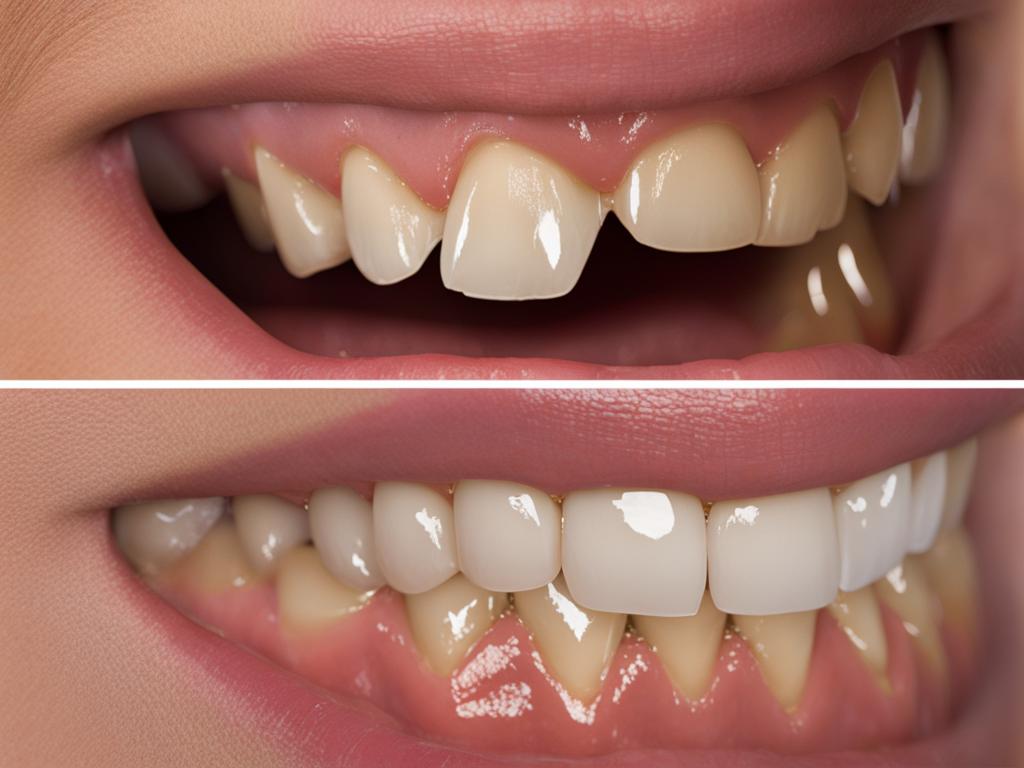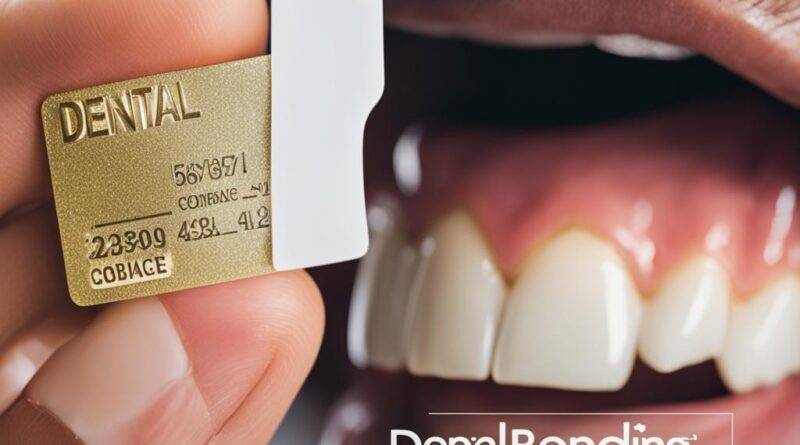Is Dental Bonding Covered by Insurance? Find Out Today!
Dental bonding is a popular cosmetic dental procedure that can effectively address various dental flaws such as cracks, chips, gaps, and stains. It is a cost-effective and minimally invasive option for improving dental aesthetics. However, when it comes to insurance coverage, there are certain factors to consider.
In general, dental insurance plans do not cover cosmetic procedures, including dental bonding, which is primarily done for aesthetic purposes. However, there may be exceptions for functional reasons, such as repairing a cracked tooth to prevent further damage. To determine the extent of coverage for dental bonding, it is crucial to contact your insurance provider and inquire about their specific policies.
Understanding your insurance coverage is essential to plan your dental treatment accordingly. Keep in mind that there might be waiting periods or limitations on the number of times dental bonding can be covered within a specific timeframe. Consulting with your insurance provider will provide clarity on the coverage and any potential out-of-pocket expenses.
Key Takeaways:
- Dental bonding is a cosmetic dental procedure that can address dental flaws such as cracks, chips, gaps, and stains.
- Dental insurance generally does not cover cosmetic procedures like dental bonding.
- Exceptions may exist if dental bonding is necessary for functional reasons, such as repairing a cracked tooth.
- It is crucial to contact your insurance provider to understand the specific coverage and any applicable waiting periods.
- Consulting with dental professionals will help you make informed decisions about dental bonding and explore available treatment options.
What is Dental Bonding and How Does It Work?
Dental bonding is a versatile cosmetic dental procedure that can address a variety of dental flaws, including cracks, chips, gaps, and stains. It involves the application of a tooth-colored composite resin to the affected tooth or teeth, which is then shaped, trimmed, and polished to restore a natural-looking appearance. The resin bonds to the tooth, providing strength and durability. Dental bonding is a quick and relatively straightforward treatment that can often be completed in just one visit to the dentist.
The process of dental bonding begins with the roughening of the tooth surface using a special conditioning gel. This helps the composite resin adhere securely to the tooth. The resin is then applied to the tooth in layers and carefully shaped to achieve the desired result. A curing light is used to harden each layer of resin before the next one is applied. Once the desired shape and appearance are achieved, the bonded tooth is polished to seamlessly blend in with the surrounding teeth.
Dental bonding offers several advantages. It is a conservative treatment option that requires minimal alteration of the natural tooth structure. It is also relatively affordable compared to other cosmetic dental procedures such as veneers or crowns. The composite resin used in dental bonding is durable and can withstand normal biting and chewing forces. However, it is important to note that bonding materials can be prone to staining over time, especially if exposed to certain foods and drinks like coffee, tea, and red wine. It is recommended to avoid or minimize consumption of these staining substances to maintain the appearance of bonded teeth.
In summary, dental bonding is a cosmetic dental procedure that uses composite resin to address a range of dental flaws. It is a simple and cost-effective treatment option that can be completed in a single visit. With proper care, dental bonding can provide long-lasting results, though it may require occasional touch-ups to maintain its appearance. If you have dental flaws that you would like to address, dental bonding may be a suitable solution to consider.
The Benefits of Dental Bonding
Dental bonding offers several benefits, making it a popular choice for addressing cosmetic dental issues. Firstly, it is an affordable treatment option compared to other cosmetic procedures such as veneers or crowns. This makes dental bonding accessible to a wider range of individuals who want to improve their smiles. Additionally, dental bonding is a minimally invasive procedure that requires minimal tooth preparation. Unlike other treatments that may require extensive enamel removal, bonding preserves more of the natural tooth structure.
Another significant benefit of dental bonding is its versatility. It can be used to address a variety of cosmetic dental issues, including cracked or chipped teeth, gaps between teeth, and tooth discoloration. In many cases, multiple concerns can be treated in a single visit, saving patients time and reducing the need for multiple appointments.
Furthermore, dental bonding provides natural-looking results. The composite resin used in the procedure is matched to the color of the patient’s teeth, ensuring a seamless blend with the natural tooth structure. This makes the bonding virtually indistinguishable from the surrounding teeth, enhancing the overall aesthetic appearance of the smile.
In summary, dental bonding offers several advantages for individuals seeking to improve their smiles. It is an affordable, minimally invasive option that can address various cosmetic dental issues. With its versatility and natural-looking results, dental bonding is a popular choice for those looking to enhance their dental aesthetics.
Table: A Comparison of Dental Bonding and Other Cosmetic Treatments
| Dental Bonding | Veneers | Crowns | |
|---|---|---|---|
| Affordability | ✓ | ✕ | ✕ |
| Minimally Invasive | ✓ | ✕ | ✕ |
| Tooth Preparation | Minimal | Extensive | Extensive |
| Treatment Time | Single Visit | Multiple Visits | Multiple Visits |
| Durability | Up to 10 years | 10+ years | 10+ years |
Note: The table provides a general comparison and may vary depending on individual cases. It is important to consult with a dental professional to determine the most suitable treatment option for specific dental needs.
Quote:
“Dental bonding offers an affordable and minimally invasive solution for addressing cosmetic dental issues. With its natural-looking results, it can enhance the aesthetics of a smile while preserving the natural tooth structure.” – Dr. Smith, Cosmetic Dentist
Does Dental Insurance Cover Dental Bonding?
When it comes to dental bonding, one of the main questions patients often have is whether it is covered by dental insurance. Dental bonding is a cosmetic dental procedure that aims to address dental flaws such as chips, cracks, gaps, and stains. However, since it is primarily a cosmetic procedure, dental insurance plans typically do not cover it. Dental insurance tends to focus on covering treatments that are necessary for maintaining oral health and functionality, rather than purely aesthetic procedures.
That being said, there may be exceptions to this general rule. In some cases, dental insurance plans may provide coverage for dental bonding if it is deemed necessary for functional reasons, such as repairing a cracked tooth to prevent further damage or restoring the structure of a tooth affected by decay. It is important to contact your dental insurance provider to clarify their specific coverage policies and any applicable waiting periods.
Keep in mind that even if dental insurance partially covers dental bonding for functional reasons, you may still be responsible for a portion of the cost. It is essential to review your insurance plan and understand the details of coverage, reimbursement policies, and any potential out-of-pocket expenses.
Factors to Consider
- Review your dental insurance plan to understand the coverage and limitations related to cosmetic dental procedures.
- Contact your dental insurance provider to inquire about coverage for dental bonding and whether there are any specific requirements for reimbursement.
- Consider alternative financing options if dental insurance coverage is limited or not available.
- Consult with your dentist to explore other cosmetic dental treatments that may be suitable for your needs and budget.
Table: Dental Insurance Coverage for Dental Bonding
| Dental Insurance Provider | Coverage for Dental Bonding |
|---|---|
| Provider A | Partial coverage for functional dental bonding |
| Provider B | No coverage for cosmetic dental procedures |
| Provider C | Partial coverage for functional dental bonding with prior authorization |
Table: Dental insurance coverage for dental bonding varies depending on the provider. It is essential to contact your insurance provider directly to understand their specific policies and requirements.
Overview of Dental Bonding Procedure
Dental bonding is a popular cosmetic dental procedure that involves the application of composite resin to the enamel of the teeth. This procedure aims to restore the appearance and functionality of the teeth, addressing issues such as chips, cracks, gaps, and discoloration. Dental bonding is a relatively simple and quick treatment that can be completed in a single visit.
The dental bonding procedure begins with the roughening of the tooth surface to ensure better adhesion of the composite resin. A tooth-colored resin is then applied and carefully shaped to achieve the desired result. A curing light is used to harden the resin, creating a durable bond with the enamel. After shaping and trimming the resin, the dentist polishes it to blend seamlessly with the natural teeth.
Dental bonding offers both tooth restoration and aesthetic enhancement benefits. It can strengthen damaged teeth and improve their appearance while preserving the majority of the natural tooth structure. This conservative approach makes dental bonding an attractive option for patients seeking a minimally invasive procedure.

Table: Dental Bonding Procedure Steps
| Step | Description |
|---|---|
| 1 | Roughening the tooth surface |
| 2 | Applying and shaping the resin |
| 3 | Hardening the resin with a curing light |
| 4 | Shaping and trimming the resin |
| 5 | Polishing the resin for a natural appearance |
The dental bonding procedure is a versatile option that can be used to address various dental flaws. By opting for dental bonding, individuals can achieve a more confident smile without the need for extensive tooth preparation or removal. However, it is important to note that dental bonding is not suitable for all cases. Your dentist will evaluate your specific dental concerns and recommend the most appropriate treatment plan for you.
Factors Affecting the Cost of Dental Bonding
The cost of dental bonding can vary based on several factors. Understanding these factors can help you estimate the potential cost of the procedure and plan accordingly. The key factors that can influence the cost of dental bonding include:
- Treatment Complexity: The complexity of the dental bonding procedure can impact the cost. Minor issues may require less time and material, resulting in a lower cost, while more extensive dental problems may require additional work and resources, increasing the overall cost.
- Location: The geographical location of the dental practice can also affect the cost of dental bonding. Practices located in urban areas or areas with a higher cost of living may have higher fees compared to those in suburban or rural areas.
- Dental Insurance Coverage: Dental insurance coverage for dental bonding can vary depending on the individual insurance plan. While cosmetic procedures are typically not covered, there may be exceptions for functional reasons. Contacting your insurance provider to understand your coverage can help you determine potential out-of-pocket expenses.
It is important to note that the cost of dental bonding can only be estimated after a consultation with a dental professional who will assess your specific needs and provide a treatment plan tailored to your situation. Consulting with your dental provider and discussing your concerns and expectations with them can help you make an informed decision about dental bonding and its associated costs.
| Factors Affecting the Cost of Dental Bonding |
|---|
| Treatment Complexity |
| Location |
| Dental Insurance Coverage |
It’s important to consider these factors and assess your individual circumstances when budgeting for dental bonding. While the cost of dental bonding can vary, it is often a more affordable option compared to other cosmetic dental treatments such as veneers or crowns. Dental bonding offers a conservative approach to address cosmetic dental issues, providing a cost-effective and minimally invasive solution.
Remember that the cost of dental bonding is an investment in your oral health and aesthetics. Prioritize open communication with your dental provider to discuss any cost concerns or financial options that may be available to help you achieve your desired results.
Long-Term Outcomes of Dental Bonding
Dental bonding can provide aesthetically pleasing results and address various dental flaws, but it is important to consider the long-term outcomes and factors that can influence the durability of the bonding material. With proper oral care and maintenance, dental bonding can last up to 10 years or longer. However, several factors can affect its longevity.
One of the common issues that can arise with dental bonding is staining. While the composite resin used in bonding is resistant to staining, certain foods and drinks, such as coffee, tea, and red wine, can cause discoloration over time. It is advisable to minimize the consumption of such staining substances and maintain good oral hygiene practices, including regular brushing and flossing, to prevent or reduce staining.
Additionally, wear and tear can affect the durability of dental bonding. Over time, the bonding material may gradually wear down or chip due to normal biting and chewing activities. Avoiding habits like biting on hard objects or opening packages with the teeth can help prolong the life of dental bonding. Regular dental check-ups and cleanings are also essential to monitor the condition of the bonding material and address any potential issues promptly.
Proper Oral Care Practices for Long-Lasting Dental Bonding
To ensure the longevity of dental bonding, it is important to follow proper oral care practices, including:
- Regular brushing: Brush your teeth at least twice a day with a soft-bristled toothbrush and fluoride toothpaste.
- Flossing: Clean between your teeth daily using dental floss or interdental cleaners.
- Avoiding staining substances: Limit the consumption of foods and drinks that can stain the teeth, such as coffee, tea, and red wine.
- Avoiding harmful habits: Refrain from biting on hard objects, opening packages with the teeth, or engaging in activities that can potentially damage the bonding material.
- Scheduling regular dental check-ups: Visit your dentist every six months for comprehensive dental exams and professional cleanings to monitor the condition of the bonding material and address any concerns.
By following these oral care practices and maintaining regular dental visits, you can help ensure the long-term success and durability of your dental bonding.

Considering Insurance Coverage for Dental Bonding
When it comes to dental bonding, understanding your insurance coverage is an important aspect to consider. While dental insurance typically does not cover cosmetic procedures like dental bonding for aesthetic reasons, there may be exceptions for functional reasons. It is crucial to review your insurance plan’s coverage details and policy restrictions to determine if dental bonding is eligible for reimbursement.
Contacting your insurance provider directly is the best way to clarify the extent of coverage for dental bonding. They can provide valuable information on any waiting periods, reimbursement policies, and the percentage of the treatment cost that may be covered. By discussing these details with your insurance provider, you can gain a better understanding of the financial aspects of dental bonding treatment.
Keep in mind that coverage for dental bonding may vary depending on your insurance provider, so it’s essential to inquire about any specific limitations or conditions. Some insurance plans may offer partial coverage for dental bonding if it is required for functional reasons, such as repairing a cracked tooth. By seeking coverage clarification, you can make informed decisions and explore alternative financing options if necessary.
| Coverage Details | Contact Information |
|---|---|
| Reimbursement Percentage | Phone: 1-800-XXX-XXXX |
| Waiting Period | Email: info@exampleinsurance.com |
| Policy Restrictions | Website: www.exampleinsurance.com |
By taking the time to understand your insurance coverage for dental bonding, you can effectively plan for the treatment and determine the financial implications. Whether you receive partial coverage or need to explore alternative financing options, having a clear understanding of your insurance policy will help you make the best decisions for your dental health.

Dental Bonding vs. Other Cosmetic Treatments
Dental bonding is a popular cosmetic dental treatment that offers an affordable and minimally invasive solution for addressing various dental flaws. However, it is important to consider how dental bonding compares to other cosmetic treatments such as veneers and crowns.
Dental Bonding
Dental bonding involves the application of composite resin to the teeth to improve their appearance and address cosmetic issues. It is a conservative approach that does not require extensive tooth preparation or removal. The composite resin used in dental bonding is durable and provides natural-looking results. Dental bonding is an excellent option for fixing minor chips, cracks, gaps, and stains. It is a relatively quick and easy treatment that can be completed in a single dental visit.
Veneers and Crowns
Veneers and crowns are also cosmetic dental treatments that can enhance the appearance of teeth. Veneers are thin shells made of porcelain or composite resin that are placed on the front surface of the teeth. They can address a wide range of cosmetic issues and provide long-lasting results. Crowns, on the other hand, are tooth-shaped caps that cover the entire tooth. They are commonly used for teeth that have extensive damage or need significant cosmetic improvement.
| Dental Bonding | Veneers | Crowns | |
|---|---|---|---|
| Affordability | High | Medium to High | High |
| Conservativeness | High | Medium | Low |
| Durability | Good (up to 10 years or longer with proper care) | Excellent (up to 15 years or longer with proper care) | Excellent (up to 15 years or longer with proper care) |
Quote: Dental bonding offers a more affordable alternative to other cosmetic treatments such as veneers or crowns. While veneers and crowns may provide more durable and long-term solutions, dental bonding is a conservative approach that does not require extensive tooth preparation or removal. Its affordability and minimally invasive nature make dental bonding a viable option for addressing cosmetic dental issues in a cost-effective and timely manner.
Ultimately, the choice between dental bonding, veneers, or crowns depends on the individual’s specific dental needs and budget. Dental bonding is a great option for minor cosmetic issues, while veneers and crowns may be more suitable for extensive dental damage or cases where a more long-lasting solution is desired. Consulting with a dental professional can help determine the most appropriate treatment for achieving the desired cosmetic results.
How to Schedule a Dental Bonding Appointment
If you’re considering dental bonding to address cosmetic dental issues, scheduling a dental bonding appointment is an important step in the process. To do so, you’ll need to find a reputable dental practice that offers dental bonding services. Once you’ve identified a suitable dental practice, you can reach out to them to inquire about scheduling a consultation.
The consultation is an essential part of the process as it allows you to discuss your specific needs and treatment goals with a dental professional. During the consultation, the dental professional will assess your oral health and determine if dental bonding is the appropriate solution for you. They will also take into consideration the complexity of your case and provide an estimated treatment timeline.
After the consultation, the dental practice will develop a treatment plan tailored to your specific requirements. This may include the number of dental bonding sessions needed, the estimated duration of each session, and the cost of the treatment. The dental practice will then schedule the bonding procedure accordingly, taking into account your availability and desired timeline.

Conclusion
Dental bonding is a popular cosmetic dentistry procedure that offers an affordable and minimally invasive solution for addressing various dental flaws. While dental insurance typically does not cover cosmetic procedures, it is important to explore your insurance coverage to determine if there are any exceptions for functional reasons. Understanding your insurance coverage can help you make informed decisions about dental bonding and explore alternative financing options if needed.
When considering dental bonding, it is essential to weigh the benefits of this treatment option. Dental bonding not only provides aesthetic enhancement but also strengthens cracked teeth and improves dental aesthetics. The use of composite resin ensures safe, durable, and natural-looking results. Moreover, dental bonding is a versatile procedure that can address multiple cosmetic issues in a single visit.
While dental bonding offers affordability and a minimally invasive approach, it is crucial to evaluate all available treatment options. Although dental insurance may not typically cover the cost of dental bonding, it is worth considering the potential benefits and comparing them to other cosmetic treatments such as veneers or crowns. Dental bonding may be a more cost-effective and conservative solution that meets your dental needs.
To move forward with dental bonding, schedule an appointment with a reputable dental practice that offers this service. During the consultation, the dental professional will assess your oral health, discuss treatment goals, and develop a customized plan. By understanding your insurance coverage, exploring financing options, and consulting with dental professionals, you can make informed decisions and find the best treatment options for your dental bonding needs.
FAQ
Is dental bonding covered by insurance?
Dental insurance generally does not cover cosmetic procedures like dental bonding. However, there may be exceptions for functional reasons, such as repairing a cracked tooth to prevent further damage. It is important to contact your insurance provider to understand their specific coverage and any applicable waiting periods.
What is dental bonding and how does it work?
Dental bonding is a cosmetic dental procedure that uses composite resin to cover dental flaws such as cracks, chips, gaps, and stains. The resin is applied to the tooth and chemically bonds to it, providing strength and durability. The process involves roughening the tooth surface, applying the resin, using a curing light to harden it, and shaping and polishing it to restore the natural appearance of the smile.
What are the benefits of dental bonding?
Dental bonding offers several benefits, including affordability and a minimally invasive nature. It is an excellent option for addressing minor dental issues in a cost-effective and timely manner. Dental bonding can strengthen cracked teeth and improve dental aesthetics. The composite resin used in bonding is safe, durable, and lifelike, providing natural-looking results. Additionally, dental bonding is a versatile procedure that can address multiple cosmetic dental issues simultaneously.
Does dental insurance cover dental bonding?
Dental insurance coverage for dental bonding varies depending on the insurance provider and the specific circumstances. In general, dental insurance plans do not cover cosmetic dental procedures, including dental bonding for purely aesthetic reasons. However, if dental bonding is required for functional reasons, such as repairing a cracked tooth to prevent further damage, there may be partial coverage. It is important to contact your insurance provider to inquire about coverage, waiting periods, and any other relevant parameters.
What does the dental bonding procedure involve?
The dental bonding procedure involves applying composite resin directly to the tooth’s enamel to restore its appearance and functionality. The resin is shaped and hardened using a curing light to create a strong bond. Dental bonding can be used for tooth restoration and aesthetic enhancement, addressing issues such as chips, cracks, gaps, and discoloration. The procedure is relatively quick and can be completed in a single visit.
What factors affect the cost of dental bonding?
The cost of dental bonding can vary depending on factors such as the complexity of the treatment, the location of the dental practice, and the extent of dental insurance coverage. While dental insurance may provide some coverage for functional dental bonding, it is important to consider out-of-pocket costs. Consulting with your insurance provider and the dental practice can help you understand the expected costs and explore any available financing options.
How long does dental bonding last?
Dental bonding can last up to 10 years or longer with proper oral care. However, the durability of dental bonding can be influenced by factors such as staining from foods and drinks and general wear and tear. Regular dental check-ups and cleanings can help prolong the life of dental bonding. It is crucial to follow proper oral care practices, including regular brushing, flossing, and avoiding habits that can damage the bonding material.
Does dental insurance cover dental bonding?
While dental insurance may not typically cover cosmetic dental procedures like dental bonding, it is important to review the specific coverage details and policy restrictions of your insurance plan. Some insurance providers may offer partial coverage for functional dental bonding, depending on the circumstances. Contacting your insurance provider directly and clarifying the extent of coverage, reimbursement policies, and any applicable waiting periods can help you understand the financial aspects of dental bonding treatment.
How does dental bonding compare to other cosmetic treatments?
Dental bonding offers a more affordable alternative to other cosmetic treatments such as veneers or crowns. While veneers and crowns may provide more durable and long-term solutions, dental bonding is a conservative approach that does not require extensive tooth preparation or removal. Its affordability and minimally invasive nature make dental bonding a viable option for addressing cosmetic dental issues in a cost-effective and timely manner.
How can I schedule a dental bonding appointment?
To schedule a dental bonding appointment, you can contact a reputable dental practice that offers dental bonding services. You may need to schedule a consultation to discuss your specific needs and treatment goals. The dental professional will assess your oral health and determine if dental bonding is the appropriate solution for you. They will then develop a treatment plan and schedule the bonding procedure accordingly.

